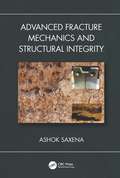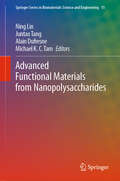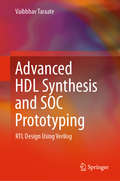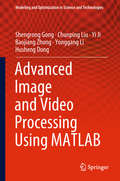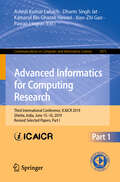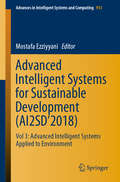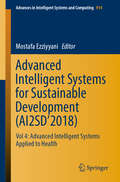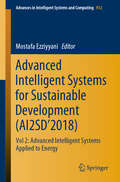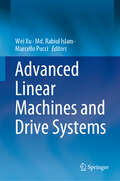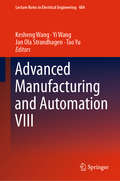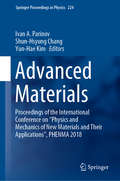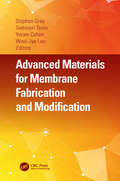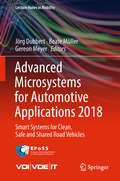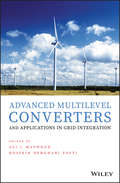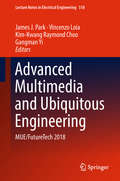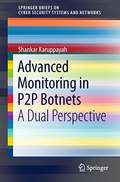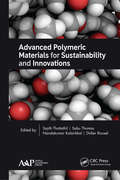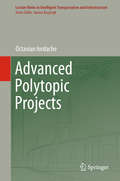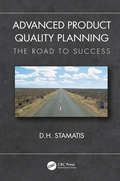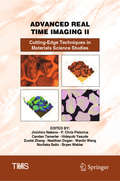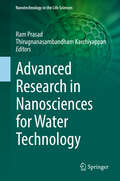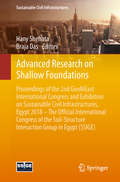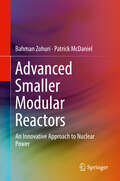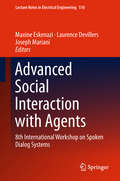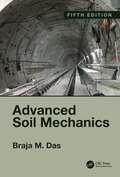- Table View
- List View
Advanced Fracture Mechanics and Structural Integrity
by Ashok SaxenaAdvanced Fracture Mechanics and Structural Integrity is organized to cover quantitative descriptions of crack growth and fracture phenomena. The mechanics of fracture are explained, emphasizing elastic-plastic and time-dependent fracture mechanics. Applications are presented, using examples from power generation, aerospace, marine, and chemical industries, with focus on predicting the remaining life of structural components and advanced testing metods for structural materials. Numerous examples and end-of-chapter problems are provided, along with references to encourage further study.The book is written for use in an advanced graduate course on fracture mechanics or structural integrity.
Advanced Functional Materials from Nanopolysaccharides (Springer Series in Biomaterials Science and Engineering #15)
by Ning Lin Juntao Tang Alain Dufresne Michael K. C. TamThis book describes the latest research on nanopolysaccharides in the development of functional materials, from their preparation, properties and functional modifications to the architecture of diverse functional materials. Polysaccharide-based nanoparticles, including nanocellulose, nanochitin, and nanostarch have attracted interest in the field of nanoscience, nanotechnology, and materials science that encompasses various industrial sectors, such as biomedicine, catalyst, coating, energy, optical materials, environmental materials, construction materials, and antibacterial materials. This book establishes a fundamental framework, highlighting the architecture strategies of typical functional systems based on nanopolysaccharides and integrated analysis of their significant influence and properties to various functional behaviors of materials, to help readers to fully understand the fundamental features of nanopolysaccharides and functional materials. Addressing the potential for practical applications, the book also covers the related industrial interests and reports on highly valued products from nanopolysaccharides, providing ideas for future studies in the area. Intended both for academics and professionals who are interested in nanopolysaccharides, it is also a valuable resource for postgraduate students, researchers, and engineers involved in R&D of natural polymers, nanotechnology, and functional materials.
Advanced HDL Synthesis and SOC Prototyping: Rtl Design Using Verilog
by Vaibbhav TaraateThis book describes RTL design using Verilog, synthesis and timing closure for System On Chip (SOC) design blocks. It covers the complex RTL design scenarios and challenges for SOC designs and provides practical information on performance improvements in SOC, as well as Application Specific Integrated Circuit (ASIC) designs. Prototyping using modern high density Field Programmable Gate Arrays (FPGAs) is discussed in this book with the practical examples and case studies. The book discusses SOC design, performance improvement techniques, testing and system level verification, while also describing the modern Intel FPGA/XILINX FPGA architectures and their use in SOC prototyping. Further, the book covers the Synopsys Design Compiler (DC) and Prime Time (PT) commands, and how they can be used to optimize complex ASIC/SOC designs. The contents of this book will be useful to students and professionals alike.
Advanced Image and Video Processing Using MATLAB (Modeling and Optimization in Science and Technologies #12)
by Shengrong Gong Chunping Liu Yi Ji Baojiang Zhong Yonggang Li Husheng DongThis book offers a comprehensive introduction to advanced methods for image and video analysis and processing. It covers deraining, dehazing, inpainting, fusion, watermarking and stitching. It describes techniques for face and lip recognition, facial expression recognition, lip reading in videos, moving object tracking, dynamic scene classification, among others. The book combines the latest machine learning methods with computer vision applications, covering topics such as event recognition based on deep learning,dynamic scene classification based on topic model, person re-identification based on metric learning and behavior analysis. It also offers a systematic introduction to image evaluation criteria showing how to use them in different experimental contexts. The book offers an example-based practical guide to researchers, professionals and graduate students dealing with advanced problems in image analysis and computer vision.
Advanced Informatics for Computing Research: Third International Conference, ICAICR 2019, Shimla, India, June 15–16, 2019, Revised Selected Papers, Part I (Communications in Computer and Information Science #1075)
by Ashish Kumar Luhach Dharm Singh Jat Kamarul Bin Ghazali Hawari Xiao-Zhi Gao Pawan LingrasThis two-volume set (CCIS 1075 and CCIS 1076) constitutes the refereed proceedings of the Third International Conference on Advanced Informatics for Computing Research, ICAICR 2019, held in Shimla, India, in June 2019. The 78 revised full papers presented were carefully reviewed and selected from 382 submissions. The papers are organized in topical sections on computing methodologies; hardware; information systems; networks; software and its engineering.
Advanced Intelligent Systems for Sustainable Development: Vol 3: Advanced Intelligent Systems Applied To Energy (Advances in Intelligent Systems and Computing #912)
by Mostafa EzziyyaniThis book gathers papers presented at the International Conference on Advanced Intelligent Systems for Sustainable Development (AI2SD-2018), which was held in Tangiers, Morocco on 12–14 July 2018. It highlights how advanced intelligent systems have successfully been used to develop tools and techniques for modeling, prediction and decision support in connection with the environment. <p><p> Though chiefly intended for researchers and practitioners in advanced intelligent systems for sustainable development, the book will also be of interest to those working in environment and the Internet of Things, environment and big data analysis, summarization, prediction, remote sensing & geo-information, geophysics, marine and coastal environments, and sensor networks for environment services.
Advanced Intelligent Systems for Sustainable Development: Vol 4: Advanced Intelligent Systems Applied to Health (Advances in Intelligent Systems and Computing #914)
by Mostafa EzziyyaniThis book gathers papers presented at the International Conference on Advanced Intelligent Systems for Sustainable Development (AI2SD-2018), which was held in Tangiers, Morocco on 12–14 July 2018. Highlighting the latest research and advances in the field of healthcare, it shares essential insights into the health sector, and is intended to stimulate further discussion and promote closer interdisciplinary collaboration among researchers and health professionals.
Advanced Intelligent Systems for Sustainable Development: Vol 2: Advanced Intelligent Systems Applied to Energy (Advances in Intelligent Systems and Computing #912)
by Mostafa EzziyyaniThis book gathers papers presented at the International Conference on Advanced Intelligent Systems for Sustainable Development (AI2SD-2018), which was held in Tangiers, Morocco on 12–14 July 2018. In addition to the latest research in the field of energy, it offers new solutions, tools and effective techniques, and provides essential information on smart grids, renewable and economical energy. Further, it addresses modeling, storage management and decision support in the field of energy, offering a valuable guide for researchers, professionals and all those who are interested in the development of advanced intelligent systems in the energy sector.
Advanced Linear Machines and Drive Systems
by Wei Xu Md. Rabiul Islam Marcello PucciThis book collects the latest theoretical and technological concepts in the design and control of various linear machines and drive systems. Discussing advances in the new linear machine topologies, integrated modeling, multi-objective optimization techniques, and high-performance control strategies, it focuses on emerging applications of linear machines in transportation and energy systems. The book presents both theoretical and practical/experimental results, providing a consistent compilation of fundamental theories, a compendium of current research and development activities as well as new directions to overcome critical limitations.
Advanced Manufacturing and Automation VIII (Lecture Notes in Electrical Engineering #484)
by Kesheng Wang Yi Wang Jan Ola Strandhagen Tao YuThis proceeding is a compilation of selected papers from the 8th International Workshop of Advanced Manufacturing and Automation (IWAMA 2018), held in Changzhou, China on September 25 - 26, 2018. Most of the topics are focusing on novel techniques for manufacturing and automation in Industry 4.0 and smart factory. These contributions are vital for maintaining and improving economic development and quality of life. The proceeding will assist academic researchers and industrial engineers to implement the concepts and theories of Industry 4.0 in industrial practice, in order to effectively respond to the challenges posed by the 4th industrial revolution and smart factory.
Advanced Materials: Proceedings of the International Conference on “Physics and Mechanics of New Materials and Their Applications”, PHENMA 2018 (Springer Proceedings in Physics #224)
by Ivan A. Parinov Shun-Hsyung Chang Yun-Hae KimThis book includes selected, peer-reviewed contributions from the 2018 International Conference on “Physics and Mechanics of New Materials and Their Applications”, PHENMA 2018, held in Busan, South Korea, 9–11 August 2018. Focusing on manufacturing techniques, physics, mechanics, and applications of modern materials with special properties, it covers a broad spectrum of nanomaterials and structures, ferroelectrics and ferromagnetics, and other advanced materials and composites. The authors discuss approaches and methods in nanotechnology; newly developed, environmentally friendly piezoelectric techniques; and physical and mechanical studies of the microstructural and other properties of materials. Further, the book presents a range of original theoretical, experimental and computational methods and their application in the solution of various technological, mechanical and physical problems. Moreover, it highlights modern devices demonstrating high accuracy, longevity and the ability to operate over wide temperature and pressure ranges or in aggressive media. The developed devices show improved characteristics due to the use of advanced materials and composites, opening new horizons in the investigation of a variety of physical and mechanical processes and phenomena.
Advanced Materials for Membrane Fabrication and Modification
by Stephen Gray Toshinori Tsuru Yoram Cohen Woei-Jye LauMembranes are an energy efficient separation technology that are now the basis for many water treatment and food processing applications. However, there is the potential to improve the operating performance of these separations and to extend the application of membranes to energy production, gas separations, organic solvent-based separations, and biomedical applications through novel membrane materials. This book contains 20 chapters written by leading academic researchers on membrane fabrication and modification techniques and provides a comprehensive overview on the recent developments of membrane technology. Membranes can be manufactured from a range of materials including polymeric compounds, and ceramic materials, and both these materials are considered in the book. There are 5 chapters on water and wastewater membranes that cover the fabrication of thin film (TFC) composite membranes for nanofiltration(NF)/reverse osmosis (RO)/forward osmosis (FO) applications, stimuli responsive membranes, electrospun membranes, porous ceramic membranes, and polymeric ultrafiltration (UF) manufacture and modification. There are another 6 chapters on gas separation that consider carbon membranes, zeolite membranes, silica template and metal oxide silica membranes, TFC membranes, silica membranes, and metal organic framework (MOF) membranes. Zeolite membranes are also considered for organic solvent applications, as are solvent-resistant membranes manufactured by phase inversion, ceramic-supported composite membranes, and ceramic NF membranes. The emerging areas of membranes for energy and biomedical applications have 3 and 2 chapters, respectively. Energy applications consider ion exchange membranes for use in fuel cells, membranes for electrodialysis, and membranes for use in microbial fuel cells. For biomedical applications the chapters focus on hemodialysis membranes and redox responsive membranes.
Advanced Microsystems for Automotive Applications 2018: Smart Systems for Clean, Safe and Shared Road Vehicles (Lecture Notes in Mobility)
by Jörg Dubbert Beate Müller Gereon MeyerThis volume of the Lecture Notes in Mobility series contains papers written by speakers at the 22nd International Forum on Advanced Microsystems for Automotive Applications (AMAA 2018) "Smart Systems for Clean, Safe and Shared Road Vehicles" that was held in Berlin, Germany in September 2018. The authors report about recent breakthroughs in electric and electronic components and systems, driver assistance, vehicle automation and electrification as well as data, clouds and machine learning. Furthermore, innovation aspects and impacts of connected and automated driving are covered. The target audience primarily comprises research experts and practitioners in industry and academia, but the book may also be beneficial for graduate students alike.
Advanced Multilevel Converters and Applications in Grid Integration
by Ali Iftekhar Maswood Hossein Dehghani TaftiA comprehensive survey of advanced multilevel converter design, control, operation and grid-connected applications Advanced Multilevel Converters and Applications in Grid Integration presents a comprehensive review of the core principles of advanced multilevel converters, which require fewer components and provide higher power conversion efficiency and output power quality. The authors – noted experts in the field – explain in detail the operation principles and control strategies and present the mathematical expressions and design procedures of their components. The text examines the advantages and disadvantages compared to the classical multilevel and two level power converters. The authors also include examples of the industrial applications of the advanced multilevel converters and offer thoughtful explanations on their control strategies. Advanced Multilevel Converters and Applications in Grid Integration provides a clear understanding of the gap difference between research conducted and the current industrial needs. This important guide: Puts the focus on the new challenges and topics in related areas such as modulation methods, harmonic analysis, voltage balancing and balanced current injection Makes a strong link between the fundamental concepts of power converters and advances multilevel converter topologies and examines their control strategies, together with practical engineering considerations Provides a valid reference for further developments in the multilevel converters design issue Contains simulations files for further study Written for university students in electrical engineering, researchers in areas of multilevel converters, high-power converters and engineers and operators in power industry, Advanced Multilevel Converters and Applications in Grid Integration offers a comprehensive review of the core principles of advanced multilevel converters, with contributions from noted experts in the field.
Advanced Multimedia and Ubiquitous Engineering: MUE/FutureTech 2018 (Lecture Notes in Electrical Engineering #518)
by James J. Park Vincenzo Loia Kim-Kwang Raymond Choo Gangman YiThis book presents the combined proceedings of the 12th International Conference on Multimedia and Ubiquitous Engineering (MUE 2018) and the 13th International Conference on Future Information Technology (Future Tech 2018), both held in Salerno, Italy, April 23 - 25, 2018. The aim of these two meetings was to promote discussion and interaction among academics, researchers and professionals in the field of ubiquitous computing technologies. These proceedings reflect the state of the art in the development of computational methods, involving theory, algorithms, numerical simulation, error and uncertainty analysis and novel applications of new processing techniques in engineering, science, and other disciplines related to ubiquitous computing.
Advanced Optical Methods for Brain Imaging (Progress In Optical Science And Photonics #5)
by Gerd Keiser Fu-Jen Kao Ankur GogoiCompiles topics starting from the basics of neuroscience to the most recent advances in structural and functional brain imaging technologies.<P><P> Presents focused and comprehensive description of the physical principles, instrumentation, and the most recent brain imaging applications using optical methods.<P> Addresses the development of novel techniques like adaptive optics, click chemistry reactions, artificial neural networks, and the CLARITY method in the field of brain imaging.<P> This book highlights the rapidly developing field of advanced optical methods for structural and functional brain imaging. As is known, the brain is the most poorly understood organ of a living body. It is indeed the most complex structure in the known universe and, thus, mapping of the brain has become one of the most exciting frontlines of contemporary research. Starting from the fundamentals of the brain, neurons and synapses, this book presents a streamlined and focused coverage of the core principles, theoretical and experimental approaches, and state-of-the-art applications of most of the currently used imaging methods in brain research. It presents contributions from international leaders on different photonics-based brain imaging modalities and techniques. Included are comprehensive descriptions of many of the technology driven spectacular advances made over the past few years that have allowed novel insights of the structural and functional details of neurons.<P> The book is targeted at researchers, engineers and scientists who are working in the field of brain imaging, neuroscience and connectomics. Although this book is not intended to serve as a textbook, it will appeal to undergraduate students engaged in the specialization of brain imaging.
Advanced Polymeric Materials for Sustainability and Innovations
by Sabu Thomas Sajith Thottathil Nandakumar Kalarikkal Didier RouxelThis informative volume discusses recent advancements in the research and development in synthesis, characterization, processing, morphology, structure, and properties of advanced polymeric materials. With contributions from leading international researchers and professors in academic, government and industrial institutions, Advanced Polymeric Materials for Sustainability and Innovations has a special focus on eco-friendly polymers, polymer composites, nanocomposites, and blends and materials for traditional and renewable energy. In this book the relationship between processing-morphology-property applications of polymeric materials is well established. Recent advances in the synthesis of new functional monomers has shown strong potential in generating better property polymers from renewable resources. Fundamental advances in the field of nanocomposite blends and nanostructured polymeric materials in automotive, civil, biomedical and packaging/coating applications are the highlights of this book.
Advanced Polytopic Projects (Lecture Notes in Intelligent Transportation and Infrastructure)
by Octavian IordacheThis book focuses on new developments in polytopic projects, particularly on implementation domains and case studies, as well as high-dimensional methodology. Polytopic projects are based on a general reference architecture inspired and shared by the functional organization of organisms and enterprises as informational and cognitive systems, the scientific and engineering methodology and the operational structure of existing self-evolvable and self-sustainable systems.
Advanced Product Quality Planning: The Road to Success (Practical Quality of the Future)
by D. H. StamatisThis book defines, develops, and examines the foundations of the APQP (Advanced Product Quality Planning) methodology. It explains in detail the five phases, and it relates its significance to national, international, and customer specific standards. It also includes additional information on the PPAP (Production Part Approval Process), Risk, Warranty, GD&T (Geometric Dimensioning and Tolerancing), and the role of leadership as they apply to the continual improvement process of any organization. Features Defines and explains the five stages of APQP in detail Identifies and zeroes in on the critical steps of the APQP methodology Covers the issue of risk as it is defined in the ISO 9001, IATF 16949, the pending VDA, and the OEM requirements Presents the role of leadership and management in the APQP methodology Summarizes all of the change requirements of the IATF standard
Advanced Real Time Imaging II: Cutting-Edge Techniques in Materials Science Studies (The Minerals, Metals & Materials Series)
by Jinichiro Nakano P Chris Pistorius Candan Tamerler Hideyuki Yasuda Zuotai Zhang Neslihan Dogan Wanlin Wang Noritaka Saito Bryan Webler“Real time” imaging techniques have assisted materials science studies especially for non-ambient environments. These techniques have never been collectively featured in a single venue. The book is an assembly of materials studies utilizing cutting edge real time imaging techniques, emphasizing the significance and impact of those techniques.
Advanced Research in Nanosciences for Water Technology (Nanotechnology in the Life Sciences)
by Ram Prasad Thirugnanasambandham KarchiyappanThe establishment of clean, safe water is one of the major challenges facing societies around the globe. The continued urbanization of human populations, the increasing manipulation of natural resources, and the resulting pollution are driving remarkable burden on water resources. Increasing demands for food, energy, and natural resources are expected to continue to accelerate in the near future in response to the demands of these changing human populations. In addition, the complexity of human activities is leading to a diversity of new chemical contaminants in the environment that represent a major concern for water managers. This will create increased pressure on both water quantity and quality, making it increasingly difficult to provide a sustainable supply of water for human welfare and activities. Although protection of water resources is the best long-term solution, we will also need innovative novel approaches and technologies to water treatment to ensure an adequate superior quality resource to meet these needs. Solving tomorrow’s water issues will require unique approaches that incorporate emerging new technologies. Great advances have been made in the area of nanotechnology. Due to their unique physical and chemical properties, nanomaterials are extensively used in antibacterial medical products, membrane filters, electronics, catalysts, and biosensors. Nanoparticles can have distinctly different properties from their bulk counterparts, creating the opportunity for new materials with a diversity of applications. Recent developments related to water treatment include the potential use of carbon nanotubes, nanocompositae, nanospheres, nanofibers, and nanowires for the removal of a diversity of chemical pollutants. By exploiting the assets and structure of these new materials, such as increased surface area, high reactivity, and photocatalytic action, it will be possible to create technologies that can be very efficient at removing and degrading environmental pollutants. Understanding and using these unique properties should lead to innovative, cost-effective applications for addressing the complexities of emerging needs for water treatment and protection. Although still in the early stages, research into the application of nanotechnology shows great promise for solving some of these major global water issues. This comprehensive text describes the latest research and application methods in this rapidly advancing field.
Advanced Research on Shallow Foundations: Proceedings Of The 2nd Geomeast International Congress And Exhibition On Sustainable Civil Infrastructures, Egypt 2018 - The Official International Congress Of The Soil-structure Interaction Group In Egypt (ssige) (Sustainable Civil Infrastructures)
by Hany Shehata Braja DasThis volume deals with the advanced analysis of shallow foundations. Several research studies are considered including soil plasticity, cracking, reaching the soil bearing capacity, creep, etc. Dynamic analyses together with stability analysis are also discussed. It gives wide range of topics dealing with the shallow foundations in different parts of the world. The volume is based on the best contributions to the 2nd GeoMEast International Congress and Exhibition on Sustainable Civil Infrastructures, Egypt 2018 – The official international congress of the Soil-Structure Interaction Group in Egypt (SSIGE).
Advanced Smaller Modular Reactors: An Innovative Approach to Nuclear Power
by Bahman Zohuri Patrick McDanielThis book discusses advanced Small Modular Reactors (SMRs) as a way to provide safe, clean, and affordable nuclear power options. The advanced SMRs currently under development in the U.S. represent a variety of sizes, technology options and deployment scenarios. These advanced reactors, envisioned to vary in size from a couple megawatts up to hundreds of megawatts can be used for power generation, process heat, desalination, or other industrial uses. In-depth chapters describe how advanced SMRs offer multiple advantages, such as relatively small size, reduced capital investment, location flexibility, and provisions for incremental power additions. SMRs also offer distinct safeguards, security and nonproliferation advantages. The authors present a thorough examination of the technology and defend methods by which the new generation of nuclear power plants known as GEN-IV can safely be used as an efficient source of renewable energy. Provides a unique and innovative approach to the implementation of Small Modular Reactor as part of GEN-IV technology; Discusses how Small Modular Reactors (SMRs) can deliver a viable alternative to Nuclear Power Plants (NPPs);Presents an argument defending the need for nuclear power plant as a source of energy, its efficiency and cost effectiveness, as well as safety related issues.
Advanced Social Interaction with Agents: 8th International Workshop on Spoken Dialog Systems (Lecture Notes in Electrical Engineering #510)
by Maxine Eskenazi Laurence Devillers Joseph MarianiThis book presents lectures given at the 8th International Workshop on Spoken Dialog Systems. As agents evolve in terms of their ability to carry on a dialog with users, several qualities are emerging as essential components of a successful system. Users do not carry on long conversations on only one topic—they tend to switch between several topics. Thus the authors are observing the emergence of multi-domain systems that enable users to seamlessly hop from one domain to another. The systems have become active social partners. Accordingly, work on social dialog has become crucial to active and engaging human–robot/agent interaction. These new systems call for a coherent framework that guides their actions as chatbots and conversational agents. Human–Robot/Agent assessment mechanisms naturally lend themselves to this task. As these systems increasingly assist humans in a multitude of tasks, the ethics of their existence, their design and their interaction with users are becoming crucial issues. This book discusses the essential players and features involved, such as chat-based agents, multi-domain dialog systems, human–robot interaction, social dialog policy, and advanced dialog system architectures.
Advanced Soil Mechanics, Fifth Edition
by Braja M. DasNow in its fifth edition, this classic textbook continues to offer a well-tailored resource for beginning graduate students in geotechnical engineering. Further developing the basic concepts from undergraduate study, it provides a solid foundation for advanced study. This new edition addresses a variety of recent advances in the field and each section is updated. Braja Das particularly expands the content on consolidation, shear strength of soils, and both elastic and consolidation settlements of shallow foundations to accommodate modern developments. New material includes: Recently published correlations of maximum dry density and optimum moisture content of compaction Recent methods for determination of preconsolidation pressure A new correlation for recompression index Different approaches to estimating the degree of consolidation A discussion on the relevance of laboratory strength tests to field conditions Several new example problems This text can be followed by advanced courses dedicated to topics such as mechanical and chemical stabilization of soils, geo-environmental engineering, critical state soil mechanics, geosynthetics, rock mechanics, and earthquake engineering. It can also be used as a reference by practical consultants.
